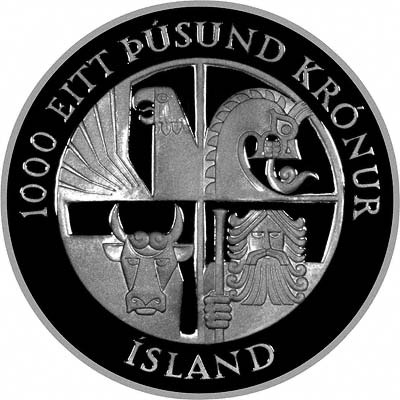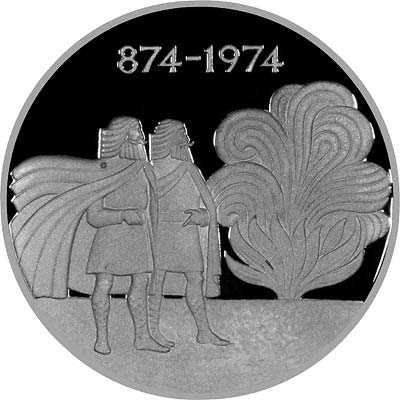| The Very Highest Quality Information... |
| Icelandic Coins |
|
| ||||||||||||||||||||||||||||||||||||
 Obverse of 1974 Icelandic Silver Proof 1000 Kronur
| ||||||||||||||||||||||||||||||||||||
|
| ||||||||||||||||||||||||||||||||||||
 Reverse of 1974 Icelandic Silver Proof 1000 Kronur
| ||||||||||||||||||||||||||||||||||||
Early Settlement
Iceland was first populated around the 870’s by the Norwegian Viking explorer Ingolfr Arnason, who was driven to seek new lands as the result of a blood feud between himself and his enemies in his native land. They established the settlement that later became Reykjavík, meaning 'Smoky Cove' (a reference to the visible volcanic activity in the area).
Norwegian Rule
Between 930 and 1262, Iceland was run as a commonwealth, however, following a civil war, the clans of Iceland desired peace, and signed an agreement in 1262 agreeing to unite Iceland with the Kingdom of Norway. Iceland then became part of the Kingdom of Denmark-Norway when the Kalmar Union (formed in 1397) broke up in 1523.
Danish Rule
Denmark-Norway was broken up in 1814, but although Iceland had originally been a Norwegian colony, Iceland was awarded to Denmark, rather than the Kingdom of Sweden, which had absorbed Norway. Iceland was prevented from trading with any country other than Denmark until 1854.
Icelandic nationalism began to rise during the 19th century, and Iceland was granted some autonomy in 1874, as well as a written constitution. This was expanded in 1903 and 1918, when Iceland was recognised as a sovereign state in personal union with the Danish Crown, although Denmark continued to be responsible for Iceland's defence and foreign affairs.
World War II and the Founding of the Republic
Denmark was overrun and occupied by the Nazis in April 1940, cutting Iceland off from its colonial motherland. The following month, Britain despatched troops to occupy Iceland in order to prevent it being used as a Nazi base. The British garrison was replaced with a US one in July 1941 to relieve the British manpower shortage.
In June of 1944, Iceland voted to declare itself an independent republic whilst Denmark was still under Nazi occupation.
Cold War
Following the conclusion of the war, Iceland renovated its fishing fleet with the foreign currency reserves it had amassed as a result of the large US garrison stationed there. It also became an important US Base. In 1958, Iceland unilaterally extended its territorial water boundaries from 4 to 12 miles off its coast, affecting British fishing vessels operating there. The issue dragged on until the 1970s, by which time Iceland had extended its recognised boundary limit to 200 miles off the coast. Military tensions between Britain and Iceland resulted in military posturing and ships on both sides ramming each other, but did not escalate into full blown military conflict. Iceland threatened to close the NATO base, and so Britain, under pressure from the US, agreed to recognise Iceland's 200 mile exclusion zone excluding foreign fishing vessels operating there without the consent of the Icelandic Government.
Iceland Today
In 2008, the Icelandic banking system collapsed during the international financial crisis of that year. The Icelandic government allowed its banks to default, causing much ire with the international community, particularly Britain, whose then-Prime Minister, Gordon Brown, controversially froze Landsbanki's assets in Britain under anti-terror legislation.
Today, Iceland is led by Prime Minister Jóhanna Sigurđardóttir, the world's first openly lesbian government leader, who came to power in 2009.
Coinage of Iceland
Iceland's first coins were pennies and pennings that were used throughout the Anglo-Scandinavian world during the 9th and 10th Centuries. During Norwegian and then Danish rule, Iceland used the coins of those counties until 1914, when the Scandinavian Monetary Union collapsed. However, it was not until 1922 when the first coins of the Icelandic krona (crown) where issued.
Iceland's first separate coins were the 10 and 25 eyrir, followed in 1925 with 1 and 2 kronur. In 1926, 1, 2 and 5 eyrir pieces were introduced. Coins of 1946 were issued without the Danish royal cypher following the declaration of an independent republic in 1944.
In 1967, following a collapse in the value of the kronur a new series of coins was issued to reflect this change. From 1967-1970, new coins of 50 eyrir, 5, 10 and 50 krona were introduced.
Due to inflation, only coins of 1, 5, 10, 50 and 100 kronur are now struck for use in circulation.
For Sale and Wanted
If you are interested in coins from Iceland please see our product index:-
Icelandic Coins
| ...at the Lowest Possible Price |
|
32 - 36 Harrowside, Blackpool, Lancashire, FY4 1RJ, England.
Telephone (44) - (0) 1253 - 343081 ; Fax 408058; E-mail: info@chards.co.uk The URL for our main page is: https://24carat.co.uk |
Web Design by Snoop |